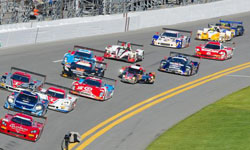|
|
The Rolex 24 at Daytona,
 also known as The 24 Hours of Daytona, is a 24-hour sports car endurance race held annually at the Daytona International Speedway. It’s run on a 3.56-mile combined road course, utilizing portions of the NASCAR tri-oval and an infield road course. It has always been held the last weekend of January, or first weekend of February, part of Speedweeks. This makes it the first major automobile race of the year in the United States. It is also the first race of the season for the TUDOR United SportsCar Championship. also known as The 24 Hours of Daytona, is a 24-hour sports car endurance race held annually at the Daytona International Speedway. It’s run on a 3.56-mile combined road course, utilizing portions of the NASCAR tri-oval and an infield road course. It has always been held the last weekend of January, or first weekend of February, part of Speedweeks. This makes it the first major automobile race of the year in the United States. It is also the first race of the season for the TUDOR United SportsCar Championship.
The Rolex 24 at Daytona has had several names over the years. Since 1991, the Rolex Watch Company is the title sponsor of the race under a naming rights arrangement, replacing Sunbank (now SunTrust) which in turn replaced Pepsi in 1984. Winning drivers of all classes receive a steel Rolex Daytona watch. In 2006, the race moved one week earlier into January to prevent a clash with the Super Bowl.
The race has been known historically as a leg of the informal Triple Crown of endurance racing. This “Triple Crown,” includes three automobile endurance races; The Rolex 24 at Daytona, 12 Hours of Sebring (Sebring, Florida) and 24 Hours of Le Mans (Le Mans, France.)
The track opened on April 5, 1959, and in 1962, a 3-hour sports car race was introduced. In 1964, the event was expanded to 2,000 km, doubling the classic 1000 km distance of similar races at Nürburgring, Spa and Monza. The distance amounted to roughly half of the distance the 24 Hours of Le Mans winners covered at the time, and was similar in length to the 12 Hours of Sebring, which was also held in Florida in March. Starting in 1966, the Daytona race was extended to the same 24-hour length as Le Mans. Unlike the Le Mans event, however, the Daytona race is conducted entirely over a closed course within the speedway arena without the use of any public streets. Also, the race is held in wintertime, when nights are at their longest, so lights are installed around the circuit for night racing. However, the stadium lights are turned on only to a level of 20%, similar to the stadium lighting setup at Le Mans, with brighter lights around the pit straight, and decent lighting similar to street lights around the circuit.
|
|
|